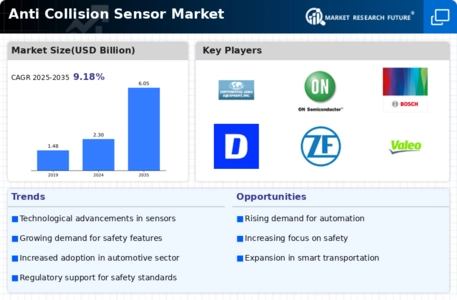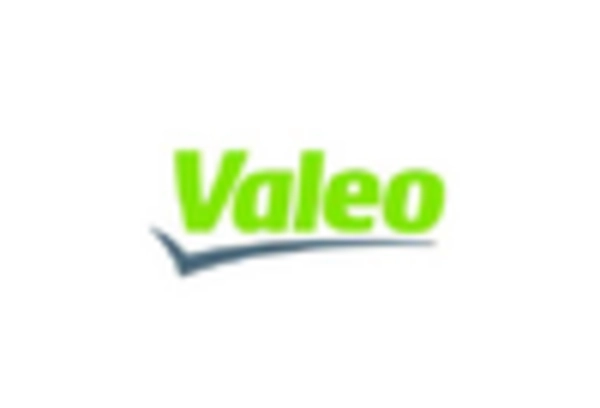Rising Demand for Safety Features
The increasing emphasis on safety in various sectors, particularly in automotive and industrial applications, drives the Anti Collision Sensor Market. As consumers and regulatory bodies prioritize safety, manufacturers are compelled to integrate advanced sensor technologies into their products. This trend is evident in the automotive sector, where the demand for vehicles equipped with collision avoidance systems has surged. According to recent data, the automotive segment alone is projected to witness a compound annual growth rate of over 10% in the coming years. This heightened focus on safety not only enhances consumer confidence but also propels the growth of the Anti Collision Sensor Market, as companies strive to meet these evolving expectations.
Regulatory Pressures and Standards
Regulatory frameworks and safety standards are crucial drivers of the Anti Collision Sensor Market. Governments worldwide are implementing stringent regulations aimed at reducing road accidents and enhancing vehicle safety. These regulations often mandate the inclusion of advanced safety features, including anti-collision sensors, in new vehicle models. For instance, several regions have established guidelines that require manufacturers to equip vehicles with collision avoidance systems by specific deadlines. This regulatory push is likely to accelerate the adoption of anti-collision technologies across various sectors, including automotive and industrial applications. As compliance becomes a necessity, the Anti Collision Sensor Market is expected to experience robust growth, driven by the need to meet these evolving standards.
Integration with Autonomous Systems
The rise of autonomous vehicles and systems is reshaping the Anti Collision Sensor Market. As the automotive industry moves towards automation, the demand for reliable anti-collision technologies is intensifying. Autonomous vehicles rely heavily on advanced sensor systems to navigate safely and avoid obstacles. The integration of anti-collision sensors with autonomous driving technologies is essential for ensuring the safety and efficiency of these systems. Market data suggests that the autonomous vehicle segment is projected to grow exponentially, further driving the demand for anti-collision solutions. This trend indicates a promising future for the Anti Collision Sensor Market, as manufacturers innovate to develop sensors that meet the stringent requirements of autonomous applications.
Growing Urbanization and Traffic Congestion
Urbanization trends contribute significantly to the expansion of the Anti Collision Sensor Market. As cities grow and traffic congestion increases, the need for effective collision avoidance systems becomes more pronounced. The rising number of vehicles on the road necessitates the implementation of advanced safety features to mitigate accidents. Data indicates that urban areas are experiencing a rapid increase in vehicle density, leading to a higher incidence of collisions. Consequently, municipalities and transportation authorities are investing in smart infrastructure that incorporates anti-collision technologies. This trend not only enhances road safety but also fosters the growth of the Anti Collision Sensor Market, as stakeholders recognize the importance of integrating these systems into urban planning.
Technological Innovations in Sensor Technology
Technological advancements play a pivotal role in shaping the Anti Collision Sensor Market. Innovations such as LiDAR, radar, and ultrasonic sensors have significantly improved the accuracy and reliability of collision detection systems. These technologies enable real-time data processing and enhance the overall performance of anti-collision systems. The integration of artificial intelligence and machine learning further augments these capabilities, allowing for predictive analytics and improved decision-making. As a result, the market is witnessing a shift towards more sophisticated sensor solutions, which are expected to capture a larger share of the industry. The continuous evolution of sensor technology is likely to drive the Anti Collision Sensor Market forward, as manufacturers seek to leverage these advancements to gain a competitive edge.

















Leave a Comment